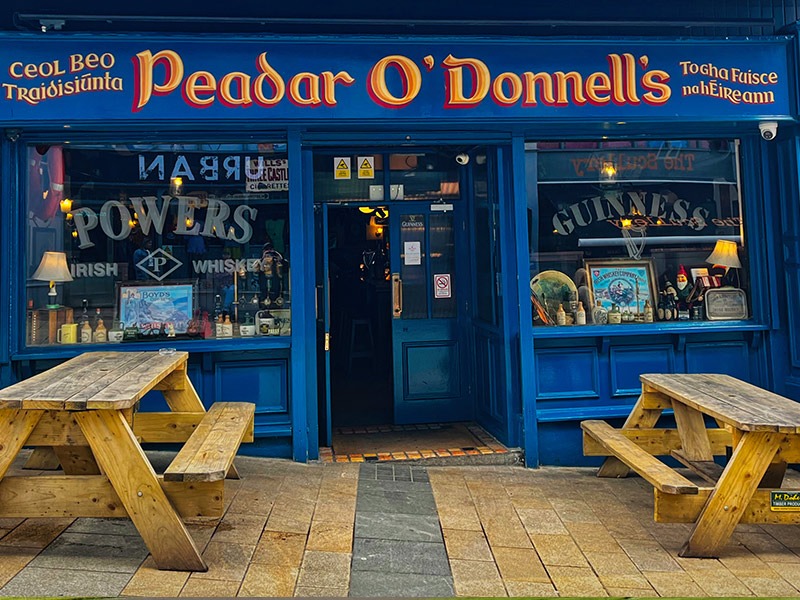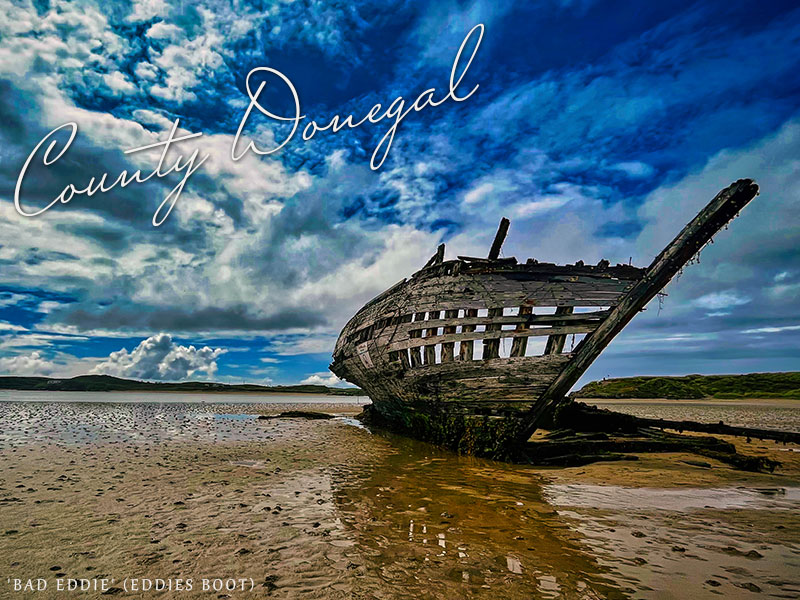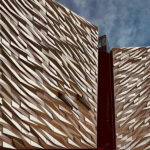The Breathtaking North of Ireland
Ireland, the green island, is famous for its picturesque landscapes, the warm hospitality of its people, and its rich history. But the spectacular coastal landscapes in the north of Ireland, from the wild cliffs of Donegal to the sandy beaches and dunes of Antrim, offer an incredible variety and are a paradise for anyone looking for something special.
The north of Ireland, where rugged nature and enchanting landscapes come together, is home to some of the most beautiful beaches and coastal stretches in Europe. From the Causeway Coastal Road, a breathtaking coastal road that runs from Belfast to Derry, to the cliffs of Slieve League in Donegal, which are among the highest sea cliffs in Europe, the north of Ireland offers an impressive variety of spectacular natural wonders and untouched nature.
In this blog post, I'm taking you on a journey along the most impressive coastal stretches, showing you the most spectacular routes and the most beautiful beaches that the north of Ireland has to offer. Get inspired by the highlights of the Northern Irish coast!
The stunning coast of Northern Ireland: 9 spectacular places
Northern Ireland: coastal stretches and natural wonders
The Giant’s Causeway – the landmark of Northern Ireland and a UNESCO World Heritage Site since 1986. The over 40,000 basalt columns, which rise like steps into the sea, are a breathtaking natural wonder. The formation of the columns is scientifically explained by volcanic activity around 60 million years ago. As the lava slowly cooled, tension cracks formed the characteristic columns, mostly in hexagonal shapes. But just as fascinating are the myths and legends surrounding the Giant’s Causeway. According to legend, the Irish giant Fionn mac Cumhaill (Finn MacCool) built the stones as a causeway to Scotland to challenge his rival, the giant Benandonner, to a fight.
The Carrick-a-Rede Rope Bridge is one of the most famous attractions on the north coast of Ireland and a popular spot for adventurers and nature lovers. The bridge connects the Northern Irish mainland with the small Carrick-a-Rede Island. It's 20 meters long and crosses the strait at a dizzying height of 30 meters. About 350 years ago, fishermen built the bridge to catch salmon from the island. Because of the often rough sea conditions, crossing by boat was often not possible. So, they built the rope bridge as a connection to the mainland.
The crossing is safe, but requires some courage - especially in windy conditions. But you are rewarded with a breathtaking panorama. On the island, you can explore the bizarre rocky landscape before crossing the swaying planks back to the mainland.
The suspension bridge is open from March to November and is owned by the National Trust.
The Causeway Coastal Route is one of the most beautiful scenic drives in the world and a highlight of any trip to Northern Ireland. The roughly 200 km long route winds from Belfast to Derry along the picturesque north coast and connects many of the country's top attractions.
One of the highlights along the route is definitely the Giant’s Causeway. Another must-see is Dunluce Castle, a castle ruin perched on a cliff high above the sea. The castle has served as a backdrop for movies like Jackie Chan’s “The Medallion” and is also a popular photo spot. But even beyond the main attractions, there’s plenty to discover along the Causeway Coastal Route: wide sandy beaches, picturesque fishing villages, green valleys, and a wild coastal landscape. If you want to explore the route on your own, you should plan for at least 2-3 days.
Whiterocks Beach in Portrush is considered one of the most beautiful beaches in Northern Ireland and all of Europe. It stands out for its fine, light-colored sand, bordered by white limestone cliffs. The bizarre rock formations give the beach its name "White Rocks." Weathering has shaped the cliffs over time into fantastic forms, creating an impressive backdrop. Thanks to its exceptional beauty, Whiterocks Beach is not only one of the highlights of the Causeway Coast but has also been named one of the most beautiful beaches in Europe. A true natural wonder that should not be missed on a trip to Northern Ireland.
The Mussenden Temple and the Downhill Demesne are two fascinating attractions on the Northern Irish coast that impress with their unique location and architecture.
The Downhill Demesne was once the estate of Frederick Hervey, the 4th Earl of Bristol and Bishop of Derry. He had the large mansion built in the 18th century on a hill above the Downhill Strand. Today, only the ruins of the once magnificent estate remain, but they still offer an impressive sight.
Downhill Demesne and Mussenden Temple are now owned by the National Trust and can be visited year-round. An unforgettable experience along the picturesque Causeway Coast.
Torr Head is the northeasternmost point of Ireland and offers a breathtaking panoramic view over the coast and the strait to Scotland. The rocky headland is located on the picturesque Causeway Coastal Route in County Antrim and is a popular destination for nature lovers. A narrow, winding road, the Torr Head Scenic Route, leads to the viewpoint. The route is considered one of the most beautiful back roads in Ireland and winds along the hilly coast with spectacular views of the sea and the landscape.
The Torr Head Scenic Route is a detour from the Causeway Coastal Route that should not be missed on a round trip through Northern Ireland. The winding route and the secluded rocky outcrop with its magnificent views leave a lasting impression of the wild beauty of the Northern Irish coastline.
Murlough Bay and Fair Head are two breathtaking natural beauties on the east coast of Northern Ireland, impressing with their dramatic coastal landscape and spectacular views. Murlough Bay is a picturesque, secluded bay surrounded by steep cliffs and green hills and has even served as a filming location for shows like Game of Thrones. It lies at the foot of the striking Fair Head, which dominates the landscape with its 196-meter-high cliffs. A narrow road leads from Ballycastle to a parking area above the bay.
From the parking lot, a path leads to the cliffs of Fair Head, the highest point of the route. The climb is a little strenuous, but well worth the effort. Once at the top, you are rewarded with a breathtaking panoramic view of the coast.
Portstewart Strand is a popular destination on the Northern Irish coast, known not only for its natural beauty but also as a filming location for the hit fantasy series Game of Thrones. The roughly 2 km long sandy beach stretches along the Atlantic coast and is bordered by a large dune area. The impressive dune landscape served as the backdrop for the coast of Dorne, the southernmost of the Seven Kingdoms, in Game of Thrones. Scenes were filmed here where Jaime Lannister and Bronn land in Dorne to rescue Myrcella.
Portstewart Strand is part of the National Trust and has a large parking area from which you can directly access the dunes. It's open all year round and is a must-visit for anyone wanting to experience the wild beauty of the Northern Irish coast.
Strangford Lough is a picturesque sea inlet in the east of Northern Ireland, renowned for its breathtaking natural landscape and historical landmarks. The bay is approximately 30 km long and 8 km wide, and it hosts over 70 islands. The area around Strangford Lough is a paradise for nature lovers. In this protected marine bay, over 2000 species of animals and plants thrive, including rare birds, seals, and even dolphins
One of the top attractions at Strangford Lough is Castle Ward. This 18th-century mansion is idyllically situated on the lakeshore and is surrounded by a large garden and park. Scenes for Game of Thrones were also filmed here

Mussenden Temple and Downhill Beach
Mussenden Temple – is a neoclassical round building from the 18th century that served as a library for the Bishop of Derry and sits 60 meters above Downhill Beach on a cliff. Downhill Beach stretches directly below the temple. The temple and the beach were used as filming locations for the series Game of Thrones, representing Dragonstone. From the building, you have a breathtaking panoramic view over the rugged Atlantic coast. Downhill Beach is part of an 11 km long stretch of beach that extends from the cliffs below Mussenden Temple to the western tip of the Causeway Coast at Magilligan Point and is located on the Causeway Coastal Route, about 14.5 km northwest of Coleraine.
Northern Ireland Map - Places to visit
The impressive Donegal coast: 9 spectacular places
Donegal: coastal stretches and natural wonders
The Slieve League Cliffs (Irish: Sliabh Liag) – are located in the southwest of County Donegal and, at a height of 601 meters, are the highest sea cliffs in Europe. They even tower over the more famous Cliffs of Moher in Clare by three times!
From the small village of Teelin, an 8 km long road leads to the cliffs. Halfway along, you pass Carrigan Head with an initial viewpoint. Further up, you go through a sheep gate to reach Bunglass Point at 300 meters elevation. There are parking spaces here, and you get a magnificent view of the entire cliff coastline. Particularly adventurous visitors can climb even higher from Bunglass Point via the “One Man’s Path”. This narrow path requires surefootedness but rewards with an even more breathtaking panorama.
Malin Head – lies on the Inishowen Peninsula in Donegal and is the northernmost point of Ireland. The rugged coastline with its steep cliffs has been shaped by the rough Atlantic over millennia and offers breathtaking views.
A popular starting point for explorations is the village of Malin, from where a winding road leads to the tip of the peninsula. At the end of the road, you reach the actual Malin Head.
A distinctive feature of Malin Head is Banba’s Crown, the highest point of the peninsula, named after one of the mythological queens of Ireland. This spot offers spectacular views and is a popular location for observing the Northern Lights, as the conditions here are nearly perfect for this natural phenomenon.
The region is not only significant for its geographical location and natural beauty but also historically relevant. During World War II, Malin Head played an important role as Irish troops, the “Irish Defence Forces”, were stationed here to maintain Ireland's neutrality. You can see this in the remains of a watchtower and the word “EIRE” laid out in huge letters with stones.
Fanad Head – On the rugged north coast of County Donegal stands the Fanad Head Lighthouse, guiding seafarers for over 200 years. Located on a green promontory at the entrance of Lough Swilly, it is one of the most beautiful lighthouses in Ireland and a popular photo spot. Steep cliffs rise here from the Atlantic, offering a magnificent view of the surrounding coast and the vast ocean.
Since 2016, the lighthouse can also be visited inside as part of guided tours. Visitors learn interesting facts about the history of the beacon and the arduous daily life of the lighthouse keepers in earlier times.
If you want to immerse yourself even more in the atmosphere of this special place, you can even stay overnight at the lighthouse. Three lovingly restored cottages, which once served as accommodation for the lighthouse keepers, are available for guests and offer an unforgettable stay.
Bloody Foreland – is a breathtaking coastal area in the far northwest of County Donegal. The name "Bloody Foreland" might sound off-putting at first, but it has a fascinating background. At sunset, the granite rocks here turn reddish, reminiscent of blood. This red coloration is due to the high iron content in the rock.
The rugged rock formations and the crashing surf give this coastal section a wild, almost mystical atmosphere. Especially during stormy weather, when the waves thunder against the cliffs, you become acutely aware of the raw power of nature. The nearby village of Dunfanaghy is an excellent starting point for exploring the area. From here, various hiking trails lead along the coast, offering spectacular views.
One of the most rewarding trails is the Horn Head Walk, which leads to the viewpoint of the same name. The path winds through a wild heathland, past steep cliffs and hidden coves. Once at the top, you are greeted with a breathtaking panoramic view of the rugged coastline and the hinterland.
Murder Hole Beach – also known as Boyeeghter Bay, is a breathtaking coastal stretch in Donegal that was previously hard to access. But since April 2022, there's an official path that allows visitors to explore this hidden gem.
A landowner has created a parking lot and a paved path to facilitate access to the beach. From the parking lot, a wide gravel path leads through the surrounding fields. The walk takes about 15-20 minutes and offers beautiful views of the mountain landscape along the way Donegals.
It is important to note that the path is steep and uneven in places. It is therefore unfortunately not suitable for baby carriages or people with walking difficulties. Due to the grazing animals along the route, dogs are also not permitted, not even on a lead. Sturdy shoes and weatherproof clothing are strongly recommended. Once you reach the beach, you will be rewarded with a breathtaking panorama.
A special highlight is the namesake “Murder Hole”, a deep cave that offers a fascinating view of the water. To find it, you need to follow the cliffs at the back end of the beach. However, caution is advised while exploring, as the currents here can be very strong.
Maghera Beach and the adjacent caves are an impressive natural spectacle on the coast of County Donegal. They are located not far from the small town of Ardara on the rugged peninsula that separates Loughros More from Donegal Bay.
Maghera Beach stretches over several kilometers along the bay. Especially at low tide, the full expanse of the beach is revealed, extending far into the bay. At the western end of the beach, there is a fascinating cave system that can be explored at low tide. Over 20 caves, arches, and tunnels have been carved into the rocks here, inviting adventurous exploration. However, these are only accessible at low tide, and it is crucial to pay attention to the tides.
Just one kilometer from Maghera Beach lies another natural spectacle: the Assaranca Waterfall. Especially after rainfall, the water masses impressively plunge down and make their way to the sea.
Maghera Beach is located about 10 kilometers west of Ardara. You can reach a small parking lot via the narrow coastal road, from which the beach can be reached on foot in just a few minutes.
Silver Strand – Hidden in a picturesque bay near the village of Malin Beg in the southwest of County Donegal, lies a true gem: Silver Strand. This breathtaking beach owes its name to the fine, light sand that shimmers silver in the sun, creating a fascinating contrast with the turquoise water.
To reach the beach, however, you must first overcome a challenge: the descent to the beach. This is done via a steep staircase carved into the rock. Many steps lead down, and the climb back up can be quite strenuous. But the effort is worth it, as you are rewarded with a truly spectacular view once you reach the bottom.
Just a few kilometers away lies the picturesque village of Glencolumbkille, known for its traditional music and the Folk Village Museum. Here, you can immerse yourself in the past and experience rural life in the 18th century. Additionally, many scenes for the film “In the Land of Saints and Sinners” starring Liam Neeson were filmed here
Crohy Head – On the rugged west coast of County Donegal, there is a place of breathtaking beauty: Crohy Head. This spectacular coastal area is located on the Mullaghmullan Peninsula, about 12 km west of the village of Maghery
The undisputed highlight of Crohy Head is the majestic sea stack “The Breeches”. This freestanding rock is connected to the mainland by a natural arch and resembles a giant pair of breeches – hence the name “Breeches,” which means knee-breeches. The arch is a popular photo subject and offers a constantly changing spectacle depending on the tides and waves. Sometimes, water shoots through the opening with a roar, while at other times, the arch lies peacefully, reflecting in the turquoise sea. A sight that captivates visitors from all over the world. Crohy Head is a paradise for hikers and nature lovers.
Along the coast, there are various paths leading to secluded coves and hidden beaches. Although the trails are not always marked and can be somewhat uneven, the breathtaking views make every effort worthwhile. Crohy Head is slightly off the beaten path, but the journey is definitely worth it. From Maghery, a narrow coastal road leads to a small parking lot, from which you can already see the “Breeches” arch
Glenveagh National Park – Nestled in the rugged landscape of the Derryveagh Mountains in the northwest of County Donegal, you'll find Glenveagh National Park. Covering an area of over 16,500 hectares, it's the second-largest national park in Ireland and offers visitors a breathtaking wilderness of rugged mountains, pristine lakes, and dense oak forests.
The heart of the park is the idyllic Lough Veagh. On its shore stands the imposing Glenveagh Castle, a mansion from the late 19th century originally built as a hunting lodge. With its crenellated tower and well-maintained gardens, it forms a charming contrast to the wild beauty of the surrounding nature.
The expansive grounds of the park can be explored via a network of hiking trails. The Glenveagh National Park is accessible from N56 from Letterkenny in about 45 minutes. Parking is available at the visitor center and at various starting points for hikes.

Fanad Head Lighthouse
Fanad Head Lighthouse – was first lit in 1817 and is considered one of the most beautiful lighthouses in Ireland. It is located at the northern tip of the Fanad Peninsula and majestically overlooks the Atlantic Ocean. The lighthouse offers a unique accommodation experience in three renovated former lighthouse keeper's cottages right next to the lighthouse. It's the perfect opportunity to take a digital detox and experience the rugged Atlantic coast up close. 😉 Bookings can be made through the official lighthouse website: https://fanadlighthouse.com
Donegal Map - Places to visit
What can I expect from the north of Ireland?
Dive into the North of Ireland, a destination that touches both the heart and the mind. Immerse yourself in the rich history and vibrant culture of the North. Experience the hospitality of the locals with a visit to one of the traditional pubs, where the heart of Irish culture beats. The North of Ireland also offers a variety of hiking trails through picturesque valleys, wild cliffs, and along breathtaking coastal landscapes. In my opinion, you can also find some of the most beautiful beaches that Ireland has to offer here.
In Northern Ireland, visitors can expect a unique blend of breathtaking nature, profound history, and vibrant culture. The untouched landscapes of Donegal and geological wonders like the Giant’s Causeway offer spectacular natural experiences, while cities like Derry provide deep insights into the complex history of the Northern Ireland conflict. The lively music scene, found in the cozy pubs, offers a warm, welcoming atmosphere that reflects Ireland's cultural identity.
In short, Northern Ireland is a must-visit for anyone who wants to experience the combination of natural beauty, historical significance, and cultural vibrancy in one impressive trip.
Northern Ireland, where the Guinness is as black as the night and the music goes straight to your heart! Slainte!

🇮🇪 What`s the Craic? Redewendungen über die Du früher oder später im Norden Irlands stolperst 🗣️✨
https://goodcraic.de/
#nordirland #irland #redewendung #irischekultur #goodcraic

Magheraclogher Beach and Bád Eddie
#donegal #magheraclogherbeach #badeddie #bunbeg #ireland

🏰 Malin Beg und Napoleonischer Signalturm, County Donegal ✨
Der Turm wurde während der Napoleonischen Kriege gebaut und diente als Kommunikationsmittel, um vor möglichen Invasionen zu warnen. Diese Türme wurden entlang der irischen Küste gebaut und dienten als Kommunikationsmittel, indem sie Signale von einem Turm zum nächsten weiterleiteten, um schnell Nachrichten über feindliche Aktivitäten zu verbreiten.
Heute ist er eine faszinierende Ruine und man hat von hier aus einen spektakulären Blick über die Malin Bay.
#malinbeg #donegal #ireland #signaltower #wildatlanticway

Silver Strand, Malin Beg 🏖️
#malinbeg #donegal #silverstrandbeach #irland #goodcraic

📸 Fanad Head Lighthouse: Er wurde 1817 in Betrieb genommen und ist einer der schönsten Leuchttürme Irlands. ✨🌊
👉 Mehr Infos den atemberaubenden Norden Irlands findest Du über den Link in meiner Bio! 👈
#fanadheadlighthouse #donegal #irland #wildatlanticway #leuchtturm

🌊 Five Fingers Strand in Donegal 🐑

🌟 Eines der 6 beeindruckenden "Glass of Thrones"-Fenster in Belfast! 🌟 Dieses Kunstwerk befindet sich auf den Titanic Slipways, direkt neben den Titanic Studios, und ist eine Hommage an den legendären Eisernen Thron. 🪟👑
#glassofthrones #titanicslipways #titanicstudios #gameofthrones #belfast #nordirland #goodcraic

🚂 Northern Ireland Railways Zugdurchfahrt am Mussenden Temple & Downhill 🏖️ 🏛️
#northernireland #mussendentemple #downhillbeach #trainjourney #goodcraic

















